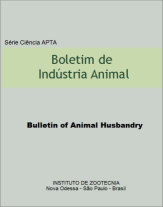Predicting carcass chemical composition of young Nellore bulls
Palabras clave:
beef cattle, feedlot, indirect determinationResumen
The direct determination of carcass composition as experimental routine, despite being the most accurate method, is time consuming, laborious and expensive. Indirect methods have been developed to estimate on quick, simple, economical and reliable ways empty body composition of beef cattle. This study was performed with the objective of developing accurate regression equations to predict carcass composition of Nellore animals using 9-10-11th ribs chemical composition and performance measures as independent variables. Sixty-seven non-castrated Nellore bulls were randomly selected for finishing period in two consecutive years (2008 and 2009) and were finished in individual pens for approximately 100 days, until they reached four millimeters of subcutaneous fat thickness over Longissimus muscle. They were slaughtered at 540 days of average age and body weight at slaughter (BW) and carcass weight (CW) were taken. The 9-10-11th ribs cut was obtained according to Hankins and Howe (1946) and weighted (RW). The carcass composition was obtained after grinding, homogenizing, sampling and analyzing the left side of the carcass. Chemical analysis of 9-10-11th ribs cut and carcass were carried for protein (RP and CP), fat (RF and CF), ashes (RA and CA) and water (RWt and CWt). Stepwise and Mallow€™s Cp options were used in PROC GLMSELECT (SAS Inst., Inc., Cary, NC) to determine significant (P<0.05) variables to be included in regression equations. Regression goodness of fit was assessed by root-mean-square error (RMSE) and determination coefficient (R²). The best regression equations found to predict each carcass chemical component were (all the variables expressed in kg): CWt = 4.295 - (0.159 x BW) + (0.788 x CW) - (22.644 x RF) + (12.273 x RWt) (R² = 0.956, RMSE = 4.215 kg); CF = -2.563 + (0.112 x BW) + (24.167 x RF) - (9.39 x RWt) (R² = 0.781, RMSE = 5.044); CP = -0.719 + (0.143 x BW) - (5.575 x RW) + (16.913 x RP) (R² = 0.706, RMSE = 3.952 kg); and CA = -4.141 + (0.046 x BW) (R² = 0.629, RMSE = 1.825 kg). Accurate equations were found to predict carcass water, protein and fat (R2>0.7). For carcass ash, the best equation found had determination coefficient (R2 = 0.629) close to 0.7, indicating that it can be used to estimate empty body ash with reasonable accuracy. Body weight is very important as predictor, being included as independent variable in equations for estimating all carcass chemical components. Estimation equations can be used to predict satisfactorily carcass chemical components of Nellore bulls.Descargas
Descargas
Publicado
Número
Sección
Licencia
Os autores não serão remunerados pela publicação de trabalhos, pois devem abrir mão de seus direitos autorais em favor deste periódico. Por outro lado, os autores ficam autorizados a publicar seus artigos, simultaneamente, em repositórios da instituição de sua origem, desde que citada a fonte da publicação original seja Boletim de Indústria Animal. A revista se reserva o direito de efetuar, nos originais, alterações de ordem normativa, ortográfica e gramatical, com vistas a manter o padrão culto da língua e a credibilidade do veículo. Respeitará, no entanto, o estilo de escrever dos autores. Alterações, correções ou sugestões de ordem conceitual serão encaminhadas aos autores, quando necessário. Nesses casos, os artigos, depois de adequados, deverão ser submetidos a nova apreciação. As opiniões emitidas pelos autores dos artigos são de sua exclusiva responsabilidade. Todo o conteúdo deste periódico, exceto onde está identificado, está licenciado sob a Licença Creative Commons Attribution (CC-BY-NC). A condição BY implica que os licenciados podem copiar, distribuir, exibir e executar a obra e fazer trabalhos derivados com base em que só se dão o autor ou licenciante os créditos na forma especificada por estes. A cláusula NC significa que os licenciados podem copiar, distribuir, exibir e executar a obra e fazer trabalhos derivados com base apenas para fins não comerciais.













